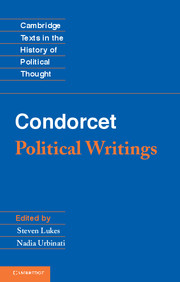Book contents
- Frontmatter
- Contents
- Condorcet: published works
- Principal events in Condorcet’s life
- Notes on the texts
- Editors’ introduction
- Suggestions for further reading
- 1 The Sketch
- 2 On slavery
- 3 On the emancipation of women
- 4 On despotism
- 5 On freedom
- 6 On revolution
- 7 Advice to his daughter (written in hiding March 1794)
- Index
1 - The Sketch
Published online by Cambridge University Press: 05 June 2012
- Frontmatter
- Contents
- Condorcet: published works
- Principal events in Condorcet’s life
- Notes on the texts
- Editors’ introduction
- Suggestions for further reading
- 1 The Sketch
- 2 On slavery
- 3 On the emancipation of women
- 4 On despotism
- 5 On freedom
- 6 On revolution
- 7 Advice to his daughter (written in hiding March 1794)
- Index
Summary
Introduction
Man is born with the ability to receive sensations; to perceive them and to distinguish between the various simple sensations of which they are composed; to remember, recognise and combine them; to compare these combinations; to apprehend what they have in common and the ways in which they differ; to attach signs to them all in order to recognise them more easily and to allow for the ready production of new combinations.
This faculty is developed in him through the action of external objects, that is to say, by the occurrence of certain composite sensations whose constancy or coherence in change are independent of him; through communication with other beings like himself; and finally through various artificial methods which these first developments have led him to invent.
Sensations are attended by pleasure or pain; and man for his part has the capacity to transform such momentary impressions into permanent sentiments of an agreeable or disagreeable character, and then to experience these sentiments when he either observes or recollects the pleasures and pains of other sentient beings.
Finally, as a consequence of this capacity and of his ability to form and combine ideas, there arise between him and his fellow creatures ties of interest and duty, to which nature herself has wished to attach the most precious portion of our happiness and the most painful of our ills.
- Type
- Chapter
- Information
- Condorcet: Political Writings , pp. 1 - 147Publisher: Cambridge University PressPrint publication year: 2012



